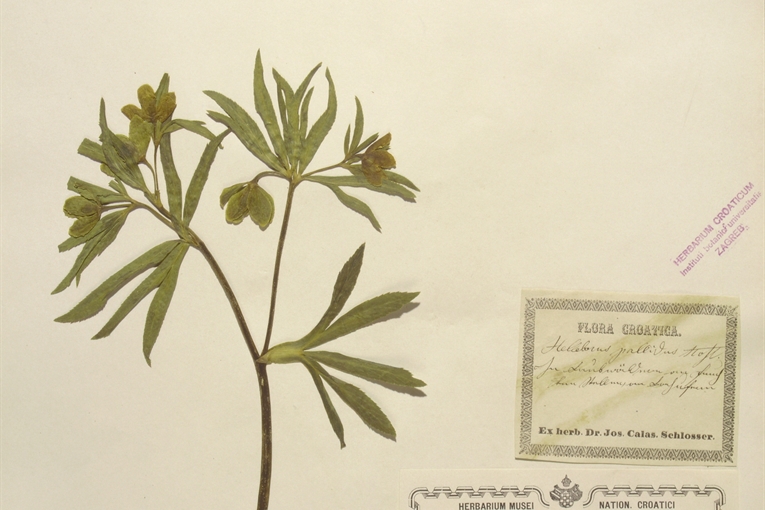

1987
Suzana Buzjak, PhD, museum adviser
Three collections

The herbarium of higher plants preserves specimens collected by field research from its establishment to the present day. It contains about 22,000 professionally fully processed specimens. The botanical material originates mainly from Croatia. Within the herbarium of higher plants, there is also a part of the Gramina Hungarica herbarium collection, by the editor and author Árpád von Degen. Gramina Hungarica contains only members of the grass family. The Museum keeps four volumes (out of a total of nine), each with 50 numbers of herbarium sheets.
This herbarium also includes a large number of herbarium sheets with specimens collected by Professor Ivo Pevalek.
In the future, the herbarium of higher plants should represent the overall flora of our country.
Suzana Buzjak, PhD, is the manager of the collection.

Herbarium Trinajstić was purchased in 2004 from our famous botanist, Professor Ivo Trinajstić, PhD, who spent most of his working life at the Faculty of Forestry and Wood Technology, University of Zagreb. This herbarium contains about 60,000 herbarium sheets that Professor Trinajstić collected during his working life. Their preventive protection and professional processing are in progress.
Botanical material comes from almost all of Europe and Asia Minor and part of North America.
Suzana Buzjak, PhD, is the manager of the collection.
The herbarium collection of the Department of Botany was established in 1987. It currently contains around 100,000 herbarium specimens of vascular plants and it is supplemented every year with newly collected botanical material.
The collection consists of three herbaria: Herbarium of higher plants (vascular flora), Herbarium Trinajstić and the Collection of algae.
The main activity of the Department of Botany consists of collecting plants, researching flora and vegetation, and scientific and professional processing of the collected botanical material, which includes preparation, identification, documentation, protection, and presentation of botanical holdings through occasional exhibitions or other educational events.

The goal of the Department of Botany of the Croatian Natural History Museum is its further development, both in the professional and scientific and educational sense, which implies further expansion of the herbarium collection with new botanical material that would ultimately represent the floristic richness and diversity of our homeland. A unique collection would thus be created, which would also be available to experts and the general public as an invaluable database. Moreover, the collection would be preserved for future generations as a document of this time.
More than 160 years ago, the National Museum housed, along with other natural objects, a collection of herbalized plants made up of gifted collections of various collectors, as well as distinguished botanists, among whom we should highlight Josip Kalasancije Schlosser and Ljudevit Vukotinović, authors of the work “Flora Croatica”. The collection was kept in the Museum until 1875, when, by the decision of the Government, it was handed over to the Department of Botany and Physiology of the newly founded University, where it became the basis of the herbarium of the Division of Botany at the Faculty of Science, University of Zagreb (Herbarium Croaticum). Today it is the largest herbarium in Croatia.
In 1987, only after the integration of three previous museums into the Croatian Natural History Museum, the Department of Botany was founded. Recent botanical material began to be collected again, and it was included in the herbarium collection by Mirjana Vrbek, PhD, who was the curator at the time. Intensive collection and processing of botanical material, in a relatively short period of time, re-created a collection that, based on how much of it was processed, was included in 1996 in the worldwide index of herbaria called Index Herbariorum (Bronx, New York).
 A specimen from the former Herbarium of the National Museum (now stored in the Herbarium Croaticum – ZA)
A specimen from the former Herbarium of the National Museum (now stored in the Herbarium Croaticum – ZA) Recently collected specimens from the Herbarium of the Croatian Natural History Museum - CNHM
Recently collected specimens from the Herbarium of the Croatian Natural History Museum - CNHMToday’s Department of Botany of the Croatian Natural History Museum employs:
Suzana Buzjak, PhD, MSc in Biology, Head of the Department of Botany, museum advisor. She has been working in the Museum since 1991. She is the manager of the Herbarium of higher plants, Herbarium Trinajstić, and the Collection of algae.
suzana.buzjak@hpm.hr
Phone: +385 1 4851700
Amadea Krznar, science and mathematics technician, senior museum technician. She has been working in the Museum since 1992.

The botanical material in the Croatian Natural History Museum is prepared for permanent storage by pressing and drying and laying it on a paper base. However, for the purposes of exhibitions, botanical material is also prepared in other ways. During the preparation of the “Otrov i lijek” exhibition (“Poison and Medicine”, 2008), plants were prepared by pressing and drying and embedding them in epoxy resin. This method of preparing plants allows for a more faithful and long-term retention of the natural appearance and colour of plants, which makes the pressed and dried specimen much more attractive.

Moreover, during the preparation of the “Zašto je pčela važnija od čovjeka?” exhibition (Why Is a Bee More Important than Man?, 2017), plants were prepared by drying in silica gel. With this method, plants retain their natural three-dimensional shape and colour after drying, and they give visitors a faithful impression of their appearance in nature.

